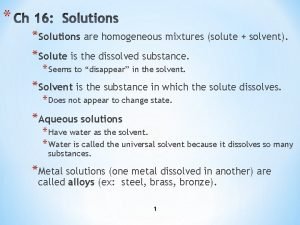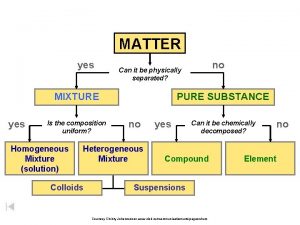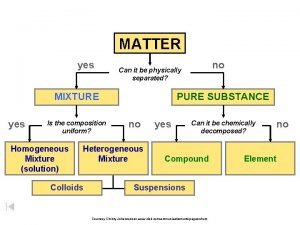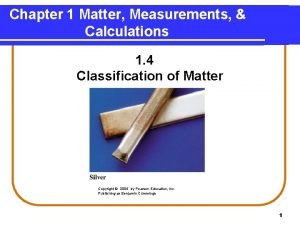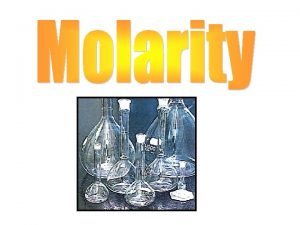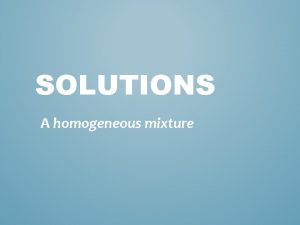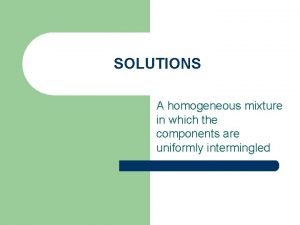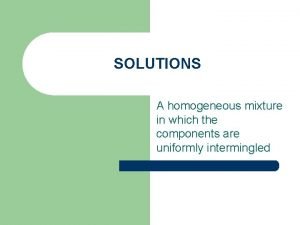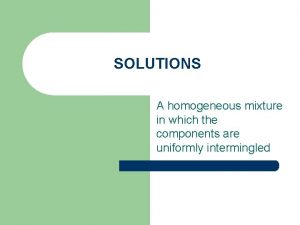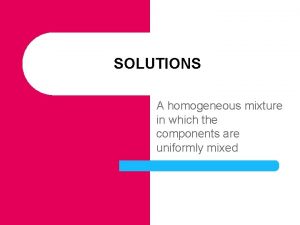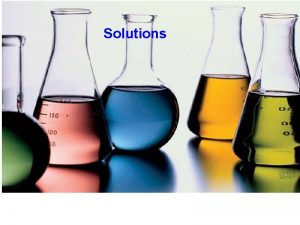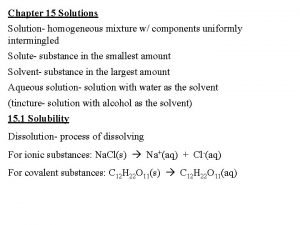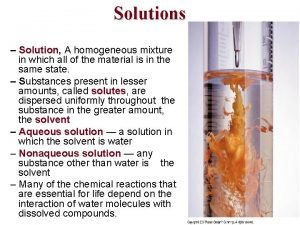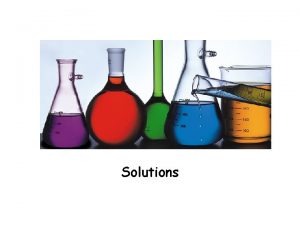SOLUTIONS A homogeneous mixture in which the components














- Slides: 14

SOLUTIONS A homogeneous mixture in which the components are uniformly intermingled

Terms Solvent – The substance present in the largest amount in a solution. The substance that does the dissolving. Solute – The other substance or substances in a solution. The substance that is dissolved.

ELECTROLYTES l l l Substances that break up in water to produce ions. These ions can conduct electric current Examples: Acids, Bases and Salts (ionic compounds)

SOLUBILITY l l Is the amount of a substance that dissolves in 100 g of water at a given temperature to produce a saturated solution “Like dissolves Like” – – Polar molecules dissolve polar molecules Nonpolar molecules dissolve nonpolar molecules

SOLUBILITY RULES l l l All common salts of Group I elements and ammonium are soluble All common acetates and nitrates are soluble All binary compounds of Group 7 (other than F) with metals are soluble except those of silver, mercury I and lead All sulfates are soluble except those of barium, strontium, calcium, silver, mercury I and lead Except for those in Rule 1, carbonates, hydroxides, sulfides and phosphates are insoluble

Terms l Saturated – l Unsaturated – l When the solution contains more solute than a saturated solution will hold at that temperature Concentrated – l When a solvent can dissolve more solute Supersaturated – l When a solution contains the maximum amount of solute When a relatively large amount of solute is dissolved Dilute – When a relatively small amount of solute is dissolved

Factors Affecting the Rate of Dissolution l Surface Area l Stirring l Temperature

Temperature vs Solubility

MOLARITY l Molarity-the number of moles of solute per liters of solution l M = molarity = moles of solute liter of solution

l Calculate the molarity of a solution prepared by dissolving 11. 5 g of Na. OH in enough water to make a 1. 50 L solution.

l Calculate the molarity of a solution prepared by dissolving 1. 56 g of HCl into enough water to make 26. 8 ml of solution.

DILUTIONS l M 1 x V 1 = M 2 x V 2 l What volume of 16 M sulfuric acid must be used to prepare 1. 5 L of a 0. 10 M H 2 SO 4 l What volume of 12 M HCl must be used to prepare 0. 75 L of a 0. 25 M HCl?

MASS PERCENT l A unit of concentration equal to the mass of solute per mass of solution part x 100 whole

l A solution is prepared by mixing 1. 00 g of ethanol with 100. 0 g of water. Calculate the mass percent of ethanol in this solution. l A 135 g sample of seawater is evaporated to dryness, leaving 4. 73 g of salt. Calculate the mass percent of salt in the saltwater.
 Is 14 karat gold homogeneous or heterogeneous
Is 14 karat gold homogeneous or heterogeneous Homogeneous and nonhomogeneous differential equations
Homogeneous and nonhomogeneous differential equations A homogeneous mixture of a solute and solvent
A homogeneous mixture of a solute and solvent Crystallization
Crystallization Homogeneous mixture vs compound
Homogeneous mixture vs compound Is the composition uniform
Is the composition uniform Volume solid liquid gas
Volume solid liquid gas Different types of mixtures
Different types of mixtures Non examples of homogeneous mixture
Non examples of homogeneous mixture Blood is homogeneous
Blood is homogeneous What is a solution homogeneous mixture
What is a solution homogeneous mixture Homogeneous mixture
Homogeneous mixture Compounds and mixtures worksheet
Compounds and mixtures worksheet Polar mixture
Polar mixture Homogeneous mixture
Homogeneous mixture


